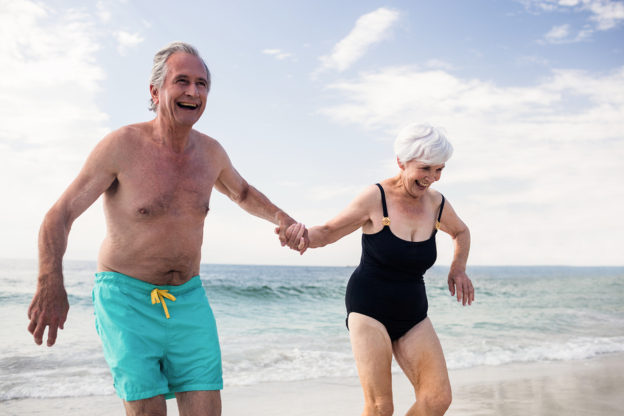By David Blyweiss, M.D., Advanced Natural Wellness
September 15, 2017
- Is life too fast-paced to exercise and eat right?
- 15 minutes to a healthier you
- Antioxidant-rich foods that can save your life
If you want to live a longer and healthier life – one without physical and mental deficits as you age – two things are absolutely necessary. And they aren’t a well-kept secret. You’ve heard them many times before…
Get plenty of physical activity and eat a healthy diet.
This is something our ancestors never even thought about. They ate off the land and were physically active from sun-up to sun-down. No trips to the supermarket or jobs sitting at a desk for them!
But in today’s modern and fast-past society, meeting these two goals seems to be a far stretch for many folks. And it’s showing.
More than two out of three Americans are overweight. One in three is pre-diabetic (and most of them don’t even know it!) Heart disease is the number one cause of death in the U.S. We’re riddled with arthritis… cancer is eating us alive… and Alzheimer’s is robbing us of our senses.
Well, guess what? It doesn’t have to be that way.
Open your arteries, improve blood flow for a new health miracle...
Did you know your circulatory system has over 60,000 miles of arteries, veins and other blood vessels, if stretched end to end?
But as you age, your blood vessels undergo changes, which may cause them to stiffen, thicken and get clogged.
GOOD NEWS! Doctors have now identified a “Miracle Molecule” inside your arteries that helps OPEN your arteries and IMPROVE blood flow.
It’s what Dr. Valentin Fuster calls it, "One of the most important discoveries in the history of cardiovascular medicine."To you, that means...
- Healthy blood pressure
- Sharper mind and memory
- Skyrocketing energy and muscular strength
- Increased pleasure and passion in the bedroom
- Improved circulation to every cell and organ in your body
Go here to discover a new natural way to significantly boost the levels of this miracle molecule in YOUR body NOW!
15 Minutes to a Healthier You
Exercise is essential to health and longevity. It helps keep your telomeres – the protective DNA caps at the ends of your chromosomes – from shortening. This is important, because shorter telomeres are associated with aging, poor health and earlier death.
Additionally, it can change the expression of your genes and add years to your life. Even a little exercise can lower your risk of a premature death by about 20%. And if you get the recommended 30 minutes a day five times a week, it can lower your risk even further.
In just a few weeks, regular exercise can also…
- Improve your cholesterol and triglyceride profiles
- Lower your fasting blood sugar levels
- Reduce blood pressure and improve arterial function
- Help you shed excess body fat
- Reduce brain shrinkage and cut your chances of Alzheimer’s by almost 40%
- Boost lung function
- Decrease pain and stiffness associated with arthritis
- Improve symptoms of depression and anxiety
You don’t have to be an American Ninja Warrior to get a good workout. You don’t even have to spend a lot of time exercising. All you need is a quick 15-minute high-intensity interval training (HIIT) workout several times a week.
Getting started is easy enough to do. Just make sure to check with your doctor before starting a new exercise program. This is especially important if you’ve been inactive for awhile.
When you have the go-ahead, begin by walking briskly for 30-seconds. Just walk as fast as you can. Then, slow down and spend three or four minutes walking regularly. Repeat four to six times.
When it gets easy to do this, change the brisk walk portion to a slight jog. Later, if your body allows, you can build up to a sprint. The key is to consistently increase intensity and take shorter amounts of time at a regular pace. This same tactic works for bicycling, rowing and swimming.
The World's Quickest Solution for Ending Prostate and Urinary Misery
This has recently been revealed to be one of the only real breakthroughs in prostate health.
The seeds of a strange fruit (sometimes called "Chinese Apples") hold powerful phytonutrients that are a revolution in prostate health.
In fact, UCLA and Veterans Administration research have now proved this to be true.
Not only that, but it may be the worlds quickest solution for ending prostate misery.
Simply stated, these phytonutrients represent a huge step beyond beta sitosterol, saw palmetto, and other phytosterols alone.
Simply click HERE if you want to have fast prostate relief...restful, uninterrupted sleep...no more constant "urges to go"...enhanced virility...and optimal prostate support for life.
Over time, you can even add in more strenuous exercises like squats, lunges and pushups. (Once you graduate to this level – or if you’re already fit enough for it – simply perform 30 seconds of the exercise, then take a short break before doing it again. Three to five sets is a good starting point.)
And what about the food you eat?
Antioxidant Rich Foods that can Save Your Life
Enjoying a wide variety of fresh, colorful, organic, plant-based foods could just save your life. These natural foods are loaded with antioxidants, vitamins, minerals and other compounds that have a positive influence on your health.
We’ve seen over and over again that people who eat the most fruits and veggies have longer telomeres than those who don’t get enough produce in their diets. They also have more positive gene expression and better mitochondrial efficiency.
In fact, fresh organic produce activates genes that protect against heart disease and diabetes. They can also turn on genes that inhibit tumor growth, stop inflammation and keep Alzheimer’s disease at bay.
So as far as foods are concerned, make sure to eat plenty of healthy fruits, veggies, beans, nuts and seeds every day. Keep your animal proteins (clean-sourced fish, meat, etc.) to about 15% of your daily diet. Choose wild-caught fish over meat as often as possible… and feel free to use extra virgin olive oil liberally.
Do this 90% of the time and you’ll automatically be eating more of the foods that activate health-preserving genes, protect against disease and help you live longer.
The other 10% of the time, have a little fun. Eat something you really enjoy. (Take time to savor it, and it will be all the more satisfying.)
SOURCES:
Cherkas LF, et al. “The association between physical activity in leisure time and leukocyte telomere length.” Arch Intern Med. 2008 Jan 28;168(2):154-8.
Handschin C, et al. The role of exercise and PGC1α in inflammation and chronic disease. Nature. 2008 Jul 24; 454(7203): 463–469.
Arem H, et al. Leisure time physical activity and mortality: a detailed pooled analysis of the dose-response relationship. JAMA Intern Med. 2015 Jun;175(6):959-67.
Kessler HS, et al. The potential for high-intensity interval training to reduce cardiometabolic disease risk. Sports Med. 2012 Jun 1;42(6):489-509.
Geda YE, Roberts RO, Knopman DS, eta al. Physical exercise, aging, and mild cognitive impairment: a population-based study. Arch Neurol. 2010 Jan;67(1):80-6.
Dunham C, et al. Effects of high-intensity interval training on pulmonary function. Eur J Appl Physiol. 2012 Aug;112(8):3061-8.
Cooney JK, et al. Benefits of Exercise in Rheumatoid Arthritis. J Aging Res. 2011; 2011: 681640.
Jayakody K, et al. Exercise for anxiety disorders: systematic review. Br J Sports Med. 2014 Feb;48(3):187-96.
Lee JY, et al. Association between dietary patterns in the remote past and telomere length. Eur J Clin Nutr. 2015 Apr 15.
Micha R, et al. Association Between Dietary Factors and Mortality From Heart Disease, Stroke, and Type 2 Diabetes in the United States. JAMA. 2017 Mar 7;317(9):912-924.
Neeha VS, et al. Nutrigenomics research: a review. J Food Sci Technol. 2013 Jun; 50(3): 415–428.







